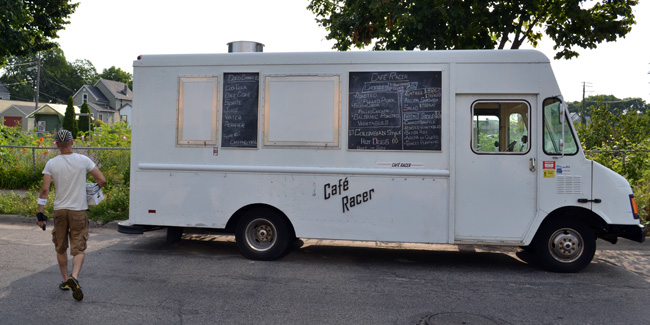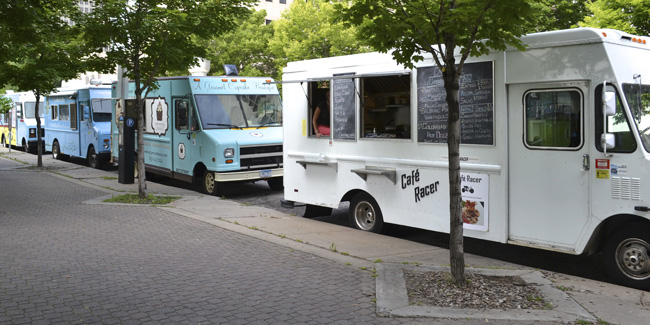
(For the first half of this article, click here.)
At about 10:40am, 20 minutes before lunch service begins, Nicole and Tony (below, left) show up for duty. Nicole arrives behind big paparazzi-shielding sunglasses and a layer or three of impeccable makeup. A friend of a friend, she started working some hours on the truck in addition to her professional gig as a hairstylist. With the air of a seasoned veteran, she goes straight to the POS system, unfazed by our unusual presence on board the truck, and begins counting out the till. Tony jumps into the truck — a tall, slim, tattooed fellow with longish blond hair. He has “Down Under” by Men at Work stuck in his head, and he sets to work getting it stuck in everyone else’s heads, too. Tony is a military buddy of Cafe Racer owner Luis Patino’s, now retired, having served all over the world, winning medals, and getting wounded. He is one of Patino’s business partners. Patino earnestly calls him a true hero. Tony helped build out the truck, he works the line, and does all manner of daily improvisational maintenance. As Patino (below, right) puts it, “Everybody needs a Tony.”
Arepas start coming out of the oven, the windows go up, and soon enough, it’s 11am. Cafe Racer is open for lunch.

A half hour into lunch service, there have been six customers. Twenty minutes later, Patino comments on how slow it seems, especially for the beautiful weather. One minute later, close to noon, a cluster of 6-8 people materializes out of nowhere. At around 12:30, there’s a surge, and it looks like the peak of the lunch rush. The Cafe Racer crew kicks into high gear. Nicole is the picture of friendly service, welcoming and patient. The reanimated ticket printer chatters away and Tony wields the tongs ably, spooning meat into paper boats with precision. Patino finishes each order off on the line with the final flourishes of garnish. The plating and portions are consistent. No matter how busy it gets, each one comes out looking great, even fussed over. It’s a graceful dance between the three of them, and highly efficient — no customer waits longer than 3 to 5 minutes for their food. Patino finds time at each hand-off to exchange some polite words with the customer. Some are repeat visitors, even fans. Many are first-timers.
Just as quickly as things sped up, the rush dies down, and it stays pretty quiet for the rest of the lunch hour. It’s surprising how quickly the two-hour window of lunch service flies by. And it’s easy to see how, over time, the truck’s systems have been refined, adjusted, tweaked, and changed, all to ensure that things can truly crank when the lines get long, which they often do at this location — up to 40 deep at times, according to the crew. Patino laments the slow day, though not resentfully. A quick shuffle through the spiked tickets reveals about 60 orders total for lunch.
At a few minutes past 1pm, service officially ends, and the windows are closed. The truck feels so different when it’s buttoned up: a bit sad, like a dog being put in a kennel. A woman from the Home Street Home truck comes by to talk shop with Patino; they compare numbers. She offers to bring some Korean BBQ tacos over. Patino accepts graciously. “My favorite part of this event is the food exchange at the end of the day,” he says. “We all swap food. That doesn’t happen at restaurants!”
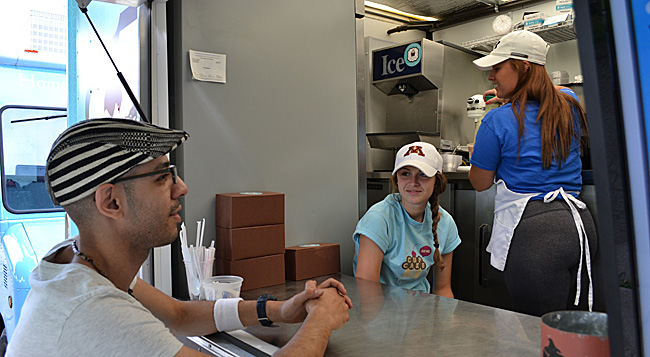
We join Patino as he walks one truck over to chat with Jessica Stone, the proprietor of the A Cupcake Social truck. The day, apparently, was more brutal for her. She seems a touch frustrated with the day, and teases Patino for his relentless optimism. She offers cupcakes. Patino chooses vanilla, and she gives him guff for making such a boring choice. We go for the Death By Chocolate. It’s excellent.
The Cafe Racer crew gathers on the grass to have a smoke and a post-game breakdown. It was unusually slow, they all agree. But no one seems to feel low about it on such a gorgeous day. Patino alternates between drags of his cigarette and slurps from the straw rising out of his Neato’s chocolate-rum shake (another end-of-day exchange). “You just can’t be in this for the money. You truly have to love serving people. I’m in this for the long haul.”
###
After a trip home for a quick nap, it’s 3:30pm, and we’re back on the road. This time it’s toward Stone Arch Park in Minneapolis, where Cafe Racer will be the sole food truck for a special 5K event sponsored by the Minneapolis Police Department called “Runnin’ With the Law.”
The sliding doors of the truck are open to the pavement, the can of Coke remains stationary on the dash, and Patino grips the wheel like a manic sea captain as the truck rumbles forth. Every so often he raps on the gas gauge like the Fonz, which wakes up temporarily to indicate the fuel level, then falls back to E. The key to maneuvering the truck in city traffic, he says, is smoothness and long, slow stops. “You have to give zero fucks about anyone else’s fucks,” he explains as we make a long, slow deceleration to a red light. “Zero fucks were given!”
He tells tales of near misses on the road. “Almost hit a homeless man once. I braked so hard that the oven came off its hinges. If I had hit him, I would have just cooked him and sold him. No one saw it! No witnesses!”
His biggest fear, other than potentially having to cover up a crime by serving his manslaughter victims in his arepas, is that of the unmarked overpass. “Oh my God,” he says. “Unmarked bridges are scary. If the top of this truck comes off, it’s all over! I don’t even wanna think about it.”
The truck bounces on toward the river. There are no low overpasses in sight.
###
We arrive at Stone Arch Park, and cops are milling around everywhere. Some are in uniform, but most are dressed for the 5K run, and one of them is Christine Patino, Luis’ wife. She helps guide the truck off-road, over the grass and bike paths to a large, enclosed circle of temporary fencing where the event is being staged. Patino backs the truck in and levels it out.
Prep is quick this time around, mostly just a short game of Tetris. Most of the food is still up to temp in the oven from lunch. We get into some of the challenges Patino faced when as he got his business off the ground.
Last year, he had planned to have Cafe Racer open and out on the streets all summer. But delays occurred. “I would say that everything and anything that could possibly go wrong in regards to building a food truck happened, short of it burning down,” he says. “Long story short, we thought we’d get the truck built in 3 months, which did not happen. October 16 of last year was our first day on the street. We were 3 months behind schedule. I call it our “testing phase,” but it was a total accident. We didn’t really have our menu defined, recipes weren’t solidified the way I wanted them, my sauces weren’t anywhere near perfected, I didn’t have a proper prep crew. I was basically doing it all on my own at that point, I didn’t have a concept of how much to pay my staff and how long to have them on for, I was spending more money than I was making, and it was such a stressful experience. It was total trial by fire — that initial $45,000 disappeared fast, to the point where we had to invest another $16,000 of our own personal money into it. It ended up being about a $61,000 project.”
Learning from the “testing phase” last fall, Patino adjusted his labor practices for 2013.
“Last year my labor costs for the season, which was short, totaled $250. This year, that could be my labor cost for one day. There are weeks where my labor costs go well over $1,000 … it’s interesting to have a relationship with my friends who are also now my employees. You feel a responsibility, because they’re so appreciative that you’re helping them eat and pay rent. I’ve never had the ability before to provide that. That is an amazing feeling. Right now I’m not paying myself. There’s not an instruction manual for this. You can’t think that you can do this alone, and that’s where a lot of people fail … they have an inability to ask for help. So now I have about a dozen part-time employees, which is crazy, to just be able to say that I have a dozen part time employees! It feels really, really weird. I want them to enjoy being part of what I consider a very humble profession, and that is serving others. The concept of serving another human being. And to see them experience the joy of that, to simply say ‘Hey guys, look at the results, look at how people are reacting to the food you made!'”
We leaned out the service window and talked a bit about the difference in being part of a tangible, direct transaction in food service, as opposed to the more abstract results of working in white collar professions.
“As a paralegal, I knew I could help people, I knew the end results could be something good, but I just felt so far removed from that result,” he says. “And I think most everyone feels that disconnect in most professions, where you don’t get that direct satisfaction of what you do with a result. But I think a lot of food truck owners can get separated from that as well — a lot of owners lose that interest in service, and it becomes all about the mighty dollar. I hope that I can focus on not losing my passion for service.”
###
The early evening sun, casting longer shadows as summer wanes toward autumn, pours into the open service windows. The food is ready, but there are no customers yet, and it’s just Patino on the truck. Most of the cops and their families are running in the 5K, and Patino expects a rush when the hungry runners cross the finish and need some dinner. So he puts the old adage to use: If you’ve got time to lean, you’ve got time to clean. “You’ve got to make the best of the down time,” he says. “You need to use this down time to be ready for the busy times. It’s important to always be doing something.”

At about 6pm, a young girl with pink braces and a long ponytail appears in the back door of the truck. This is Natalia, Patino’s younger sister, and she’ll be his window girl for the evening. She looks at home immediately, and hops up on the perch by the order window to get the cash drawer in order. She’s about to start her junior year in high school, with ambitions to go on to medical school and become a surgeon, which, as she says, would be “so badass!” Natalia and Patino engage in some sibling banter; he plays up the protective older brother role, and she prods him into divulging his youthful indiscretions.
The grassy area starts to fill up with runners, cops, and their families. There’s a K9 demo, and a S.W.A.T. vehicle on display. A bluesy bar-rock band plays some sleepy tunes on the small amphitheater stage beneath the massive power lines that cross the river and march toward the Minneapolis skyline. Dark clouds threaten rain from the southeast, but none comes. It’s a lovely evening.
Soon, the hungry masses of cops and their families start making their way toward the truck, and things get under way. As the sun gets low, people congregate around the ordering window, Natalia shouts out the orders (raising her voice just like her brother taught her), and Patino handles the gentle rush ably. The overall vibe of the event is familial and jovial; everyone seems to know each other. Mayoral hopeful Cam Winton is holding forth with a few cops, explaining how he wants to change things in the city if given the opportunity. He orders an arepa sandwich, and through the window, spies us with our notepad and camera. “This sounds really politician-y,” he says, “But have we met before?” We respond uncertainly, and he introduces himself, smiles, and walks away with his food.
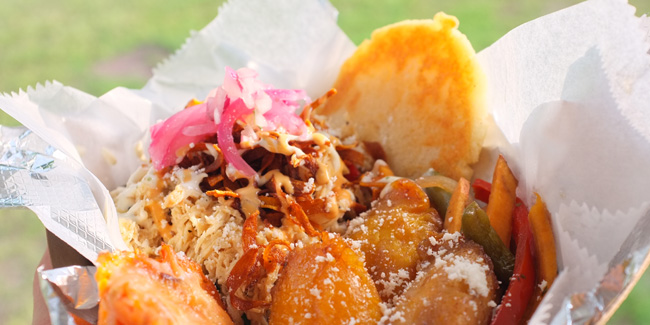
Patino offers, and we accept, our second Cafe Racer meal of the day. This time we opt for a chicken arepa sandwich, with roasted veggies, plantains, and the carrot souffle on the side. At first, we’re uncertain that it’s even possible to consume the bulging mass as a sandwich, but we’re encouraged by Patino to try, and it somehow holds together. The arepas themselves are quite sturdy, each topped with a bit of browned cheese, but they seem to sacrifice moisture for structural integrity, and taste a bit dry. This is made up for by the moistness of the fillings: very succulent achiote-braised chicken, and the usual accoutrements: pico, pickled onion, crema, pink sauce. The roasted veggies are full of pleasing vegetal texture, brightened by a touch of balsamic and apple cider vinegars. The meal is beyond filling. This is slow-release food that will keep you satisfied for a long stretch.
As people start trickling away, one woman in running gear comes up to the window and offers her compliments about the food, happy that she could assemble a tasty gluten-free meal. You can almost see Patino filing it away mentally: another feather in the cap, another boost to keep him inspired.
Brother and sister start wrapping up for the night, and we all wonder aloud about how many yards of plastic wrap the entire world goes through per day. Patino claims that it, along with aluminum foil, are the two most important things in a restaurant. The sun is completely down by this point, and the truck is back in full pre-Tetris mode: everything is stacked, bungeed, strapped, locked, and loaded. Even the ticket printer. Patino shows his sister how to read the day’s report from the POS system, and they run the numbers together: Cafe Racer netted $442 for lunch in St. Paul, and $229 for dinner service in Minneapolis. The second event saved the day, according to Patino, and he only had to shell out $30 for labor to his little sister for the evening. He seems satisfied.
We talk about the future as he shuts down the generator and closes up the windows. He finally looks a little bit tired.
“It is such an addictive thing to be able to serve someone something you put your heart and soul into. Literally, you’re putting love into it. And not just a little bit of love … the food that is coming out of my truck is something that has taken generations to come about, through the concept of sharing a meal with family. It’s about having an emotional and nostalgic experience through flavors, even if someone’s never had this kind of food before. It translates, it’s something familiar, it’s comforting. It’s the kind of stuff you can eat everyday. At least I do, and I will forever. They’re staples. And I really hope to present more food to more people in a broader medium someday.”
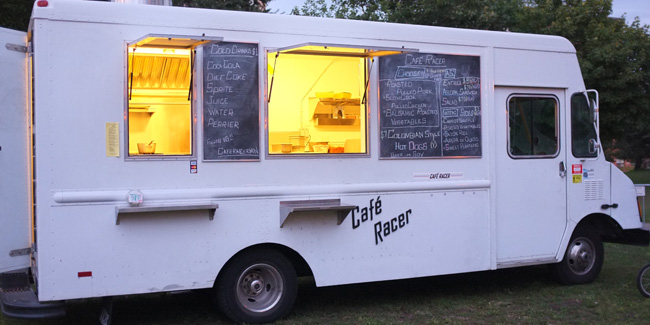
The truck is dark, and we gather up our gear as Patino gets ready to drive home and get ready for another day on the streets. This lifestyle isn’t for everyone, and we can’t help but wonder aloud before we leave: Has all the work been worth it?
Patino doesn’t hesitate at all. “Absolutely. During the entire time I was developing this plan, working extra hours, saving the money … whenever people asked me how I was doing, I always responded, ‘I am living the dream.’ And now, it’s actually totally freaking real. Even if I were to fail at this, and have everything I worked for taken away from me, that is still part of it — I would still want to just go at it again. It has been absolutely worth the struggle and the strife.”

